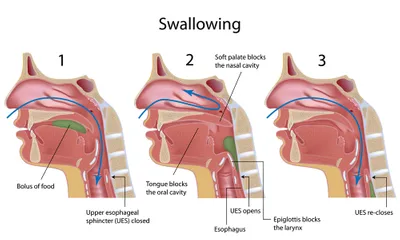Eosinophilic esophagitis (or EoE) is an inflammatory condition that causes dysphagia, which makes swallowing solid foods extremely difficult. The condition can strike any age and any gender; however, men and young boys are more prone than females to EoE.
Although the exact cause of EoE is unknown, the vast majority of doctors consider that EoE develops due to an allergen that causes the overproduction of eosinophils. This is because eosinophils overrun the system in other allergy-related conditions—like asthma, atopic dermatitis, and allergic rhinitis, which are also prevalent in those who suffer with eosinophilic esophagitis.
Here are the eight most prevalent EoE symptoms…
1. Dysphagia
Dysphagia, or the inflammation associated with EoE, is caused when eosinophils (leucocyte white blood cells) flood the inner tissues the esophagus, in reaction the flexible muscular walls of the esophageal stiffen and obstruct the passing of food through the esophagus as it travels to the stomach.
2. Chest Pain
Chest pain often arises with eosinophilic esophagitis due to difficulty and painful swallowing, particularly when it comes to solid food traveling from the normally muscular tube of the esophagus to the stomach. EoE causes the esophageal tissues to become rigid and obstruct the smooth and easy flow of food to the stomach.
3. Heartburn
It makes perfect sense that with eosinophilic esophagitis reoccurring and painful heartburn will result due to solid-food dysphagia. The heartburn often worsens if the patient lies down in a recumbent (or reclined) position, particularly following meals. Most EoE patients have little success even when treated with aggressive anti-reflux therapy (i.e., prescription acid blocker medication or a proton pump inhibitor).
4. Gagging
Dysphagia, or the difficulty swallowing, will often cause patients with EoE to gag frequently after eating a meal. This is caused by the ever-present feeling that something is caught in the throat, and indeed the patient may be experiencing solid food that is unable to travel through a swollen or scarred (a condition known as stricture) esophagus to the stomach.
5. Difficulty Sleeping
The chronic heartburn and chest and abdominal pain caused by EoE and dysphagia will often result in sleeping difficulties, particularly because heartburn and gas is often exacerbated in a prone or reclined position, making it impossible to get comfortable and fall asleep or sleep through the night.
6. Vomiting
When solid food becomes caught in the esophagus a backup may occur, and result in vomiting in young or adult patients who suffer food impaction (or food trapped inside the esophagus) that they are unable to dislodge or cough up on their own. Infants suffering from EoE may even refuse a bottle or refuse to breastfeed. When they do feed, they may arch the back and spit up as a sign of EoE.
7. Chronic Cough
A chronic cough is symptomatic to EoE. Patients will often complain of consistent or returning laryngeal symptoms—such as hoarse or labored breathing, wheezy breathing, croup-like cough (that often sounds like the barking of a seal), the feeling of a throat obstruction, and sleep-disordered breathing.
8. Loss of Appetite
It’s common for patients with EoE to associate eating with pain. An irrational aversion to certain foods (particularly solid foods) or a habit of eating slowly or refusing to eat at all may be common. This often causes children with EoE to be low weight or to experience growth delays.











